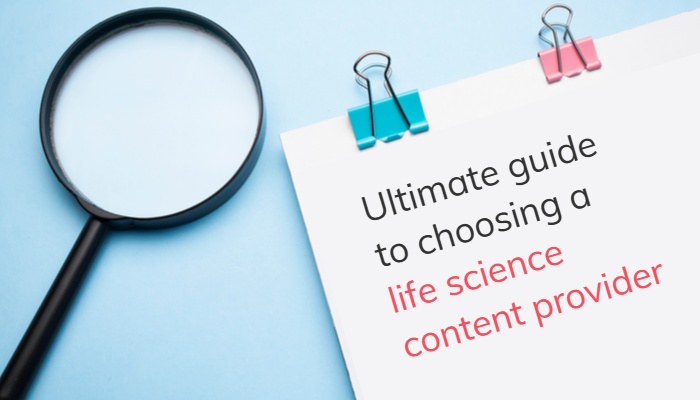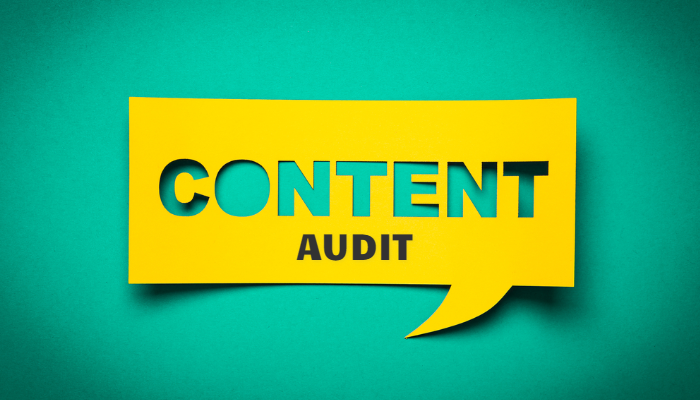In today's digital age, producing high-quality content is essential for life science companies looking to establish thought leadership, improve search engine rankings, increase website traffic, and generate leads. However, creating such content requires a uniquely blended set of skills, including technical and creative writing capabilities, which can be challenging for life science companies to find in-house. This is where external content providers come in.
Choosing the right life science content provider is crucial for achieving your marketing goals, but it can be overwhelming to know where to start. The decision-making process involves identifying your needs, finding potential providers, evaluating their qualifications and credentials, selecting the best one based on your criteria, communicating your needs and expectation, and monitoring and evaluating the results.
Our goal in this blog is to guide you through each stage of the process and help you select the best life science content provider for your needs. By the end of this blog, you'll have a clear understanding of how to find, select, and evaluate the best content provider for your organisation and be ready to take action. Whether you're looking for blog posts, whitepapers, case studies, videos, or technical documentation, our tips and strategies will help you create engaging, accurate, and informative content that meets your goals.
Identifying your life science content needs
Before you begin your search for a life science content provider, it's essential to identify your needs. The easiest way to do this is to reflect on your marketing goals and objectives. For example, do you want to increase brand awareness, generate leads, or educate your audience? The objective for each piece of content should directly feed into these goals, and will help you determine the type of content you need.
After confirming your content objectives, it’s crucial to identify the types of content you need, such as blog posts, whitepapers, case studies, videos, or technical documentation. Different content developers have different strengths and weaknesses, and some may specialise in a particular area. Therefore, identifying the content types you need will help you narrow down your search to providers with experience in producing the type of content you require.
Another important factor to consider is whether you need support with a content strategy or carrying out a content audit. A content strategy will help you align your content with your business goals and target audience, while a content audit will help you identify gaps in your existing content and opportunities for improvement. If you're unsure of what you need, a content provider with expertise in these areas can be invaluable.
If you're considering carrying out a strategic content audit, you may find our blog on how to conduct a strategic content audit in the life sciences helpful to better understand what exactly is involved.
We've also developed a 10-step assessment tool to assist life science marketers in preparing to perform a content audit.
Finally, determine your budget. Remember that high-quality content is an investment that can provide a significant return. But, it's essential to ensure that your budget reflects the value of high-quality content and the potential return on investment. A content provider with a clear understanding of your budget can help you achieve your goals within your financial constraints.
Finding potential life science content providers
Once you've identified your needs, the next step is to find potential content providers. There are two primary types of content providers: agencies and freelancers.
Agencies are typically larger organisations with a team of writers, editors, and other professionals who work together to provide a range of services. They offer a comprehensive approach to content development, with the ability to provide strategy, ideation, creation, and execution. However, they may have higher costs, and there may be communication challenges depending on the size of the team.
On the other hand, freelancers are independent contractors who work on a project basis. They tend to be more flexible and cost-efficient, but they may have limited capacity and require more hands-on management.
It's worth noting that consultants tend to evaluate brand and messaging and advise on strategy, but they rarely develop content. Therefore, if you're after those activities, you may want to assess relevant consultants, but you would likely need to engage a separate party for content development.
So, how do you start searching for potential content providers? Asking for recommendations from colleagues can be a good start, as can using search engines, directories, or social media platforms. Google searches such as 'Life science marketing agency' or ‘Life science content writing’ can help you identify providers who specialise in scientific marcoms content.
Attending conferences, events, or webinars related to life sciences and marketing is another way to network and learn about potential providers. These events can be a great opportunity to meet providers in person, ask questions, and get a sense of their expertise and approach.
No matter which method you choose, it's important to create a list of potential content providers that you can evaluate based on your criteria. Doing so will help you save time and effort in the long run and ensure that you find the best provider for your needs.
Evaluating potential life science content providers
After you have created a list of possible life science content providers, it's time to evaluate their credentials to select the best provider for your needs.
Reviewing their website and online presence is a good place to start. A professional and credible website can indicate that the provider takes their work seriously and has expertise in their field. Look for information about their team, experience, and services. Additionally, check if they have any relevant certifications, awards, or affiliations that indicate their credibility.
Next, examine their portfolio and samples to get an idea of the quality, relevance, and style of their work. In particular, look for examples of content similar to what you need and evaluate whether they meet your standards. Pay attention to their attention to detail, accuracy, and tone.
It’s also important to consider whether they have a scientific background and the number of years of practical experience they have in the life science industry. Industry expertise can ensure that they understand your audience, can communicate complex ideas accurately and effectively, and are aware of regulations and standards.
Finally, have a call with potential providers to discuss how they manage their workflow, from project commission through to invoicing. Doing so can help you assess their communication skills, responsiveness, and reliability. Ask about their process for content development, including how they handle revisions, approvals, and deadlines.
Ultimately, the evaluation process should help you identify the best content provider based on your needs and goals. Take your time and don't rush into a decision. Remember, the right provider can help you establish thought leadership, improve search engine rankings, and increase website traffic, so it’s important to find the right provider.
Selecting the best life science content provider
Now that you’ve evaluated potential content providers, it's time to select the best one based on your criteria. Start by creating a shortlist of providers that meet your needs, and analyse the strengths and weaknesses of each one based on your criteria.
Consider their experience and expertise in your industry or niche. Providers who have worked with clients similar to your business may have a better understanding of your audience and brand. Additionally, evaluate their ability to research and understand your target audience and communicate complex scientific concepts in a way that resonates with them.
It's also essential to weigh the costs and benefits of each provider. Compare their pricing, payment terms, delivery time, and support. Keep in mind that while cost is an important factor, selecting a provider based solely on price may compromise the quality of your content. Look for providers who offer transparent pricing, competitive rates, and excellent value for your investment.
Lastly, consider their creativity and responsiveness. A provider who can bring a fresh perspective and innovative ideas to your content can help you stand out from the competition. Additionally, look for providers who are responsive and easy to communicate with, as this can help ensure a smooth and efficient content development process.
Communicating your needs and expectations
Once you've selected the best content provider for your needs, it's crucial to communicate your needs and expectations clearly to ensure a successful collaboration.
Start by establishing clear goals and expectations for the content. A comprehensive brief that includes defining the topics, tone, voice, format, and style that you want the provider to follow should help ensure the content produced will meet your requirements and aligns with your brand; saving you time overall.
To help ensure that everyone is on the same page and that the project stays on track, define project timelines and deliverables, such as the deadlines, milestones, revisions, and approvals. And, be realistic about your timeline and budget, and communicate any constraints or limitations to the provider upfront.
Communication is key to a successful collaboration, so ensure that all parties are on the same page by clarifying any doubts, questions, or concerns. Be available to answer questions, provide feedback, and address any issues that arise throughout the project. Maintain open communication channels and keep the provider informed of any changes or updates to your requirements.
Monitoring and evaluating your results
Finally, after the content has been created and published, it's important to monitor and evaluate the results to ensure that the content is meeting your goals, engaging your audience and getting the best return on your investment.
Regularly review content quality and relevance by measuring key performance indicators, such as traffic, engagement, conversions, or leads will help you understand how your audience is interacting with your content and identify areas for improvement. Additionally, if the content is being used for media placements, it's essential to monitor feedback from editors.
Measuring the impact of the content on your target audience by collecting feedback, comments, or surveys can help you understand if the content is meeting their needs and if they find it engaging and informative. Use this feedback to make necessary adjustments to improve the content and achieve your goals.
What’s more, provide feedback to the provider to help them understand what worked well and what could be improved in future projects. This will help ensure that they continue to produce high-quality, engaging content that meets your needs and aligns with your brand.
Selecting a life science content provider with a proven track record
Choosing the right life science content provider can be a game-changer for your business. In the life science industry, content plays a crucial role throughout the buying process by creating brand awareness, establishing trust, driving website traffic, generating leads, and supporting sales.
In this blog, we've discussed the challenges facing life science companies when looking for a content provider, the importance of choosing the right provider, and the stages of the decision-making process. We've also covered the criteria for evaluation and selection, including identifying your needs, finding potential providers, evaluating their qualifications and credentials, selecting the best provider based on your criteria, communicating your needs and expectations, and monitoring and evaluating results.
High-quality life science content has numerous benefits, including building trust, authority, and loyalty with your audience. By providing accurate, engaging, and informative content, you can establish your brand as a thought leader and increase your visibility and credibility.
We encourage you to start the search process by contacting potential providers or requesting a proposal. If you're considering BioStrata, one of the world’s leading life science marketing agencies, we offer a range of services that can help you create high-quality, engaging content that meets your needs and aligns with your brand. With a team of experienced life science writers, editors, and content strategists, we can provide a comprehensive approach to content development that drives results.
To learn more about some of the content projects we've worked on with our clients, take a look at our recent case studies.
Contact us today to learn more about our science writing and content creation services and how we can help you achieve your life science marketing goals.





